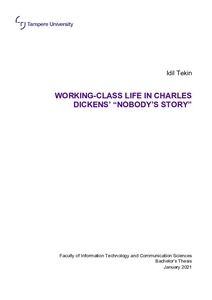Working-Class Life in Charles Dickens’ “Nobody’s Story”
Tekin, Idil (2021)
Tekin, Idil
2021
Kielten kandidaattiohjelma - Bachelor's Programme in Languages
Informaatioteknologian ja viestinnän tiedekunta - Faculty of Information Technology and Communication Sciences
This publication is copyrighted. You may download, display and print it for Your own personal use. Commercial use is prohibited.
Hyväksymispäivämäärä
2021-01-12
Julkaisun pysyvä osoite on
https://urn.fi/URN:NBN:fi:tuni-202101041030
https://urn.fi/URN:NBN:fi:tuni-202101041030
Tiivistelmä
This thesis examines Charles Dickens’ “Nobody’s Story” (1853) in relation to the economic conditions of its time. Starting from and focusing on the working-class life of the main character, this thesis explores how the story is shaped by the economic conditions of Victorian England, but at the same time responds to them, causing contradictions to arise in the text. The theoretical basis of this analysis constitutes of the materialist and dialectical framework of Marxism.
“Nobody’s Story” tells the story of Nobody, a working-class man with a family, who is dependent on the wealthier Bigwig family. This thesis approaches “Nobody’s Story” by analysing the description of the different aspects of Nobody’s working-class life. In the course of the story, Nobody encounters and struggles with issues such as education, unsanitary living conditions, a spreading disease, art and leisure. The description of his life is examined in relation to the developments of the capitalist mode of production at the time.
The results of this thesis show that the story’s criticism of social issues stays within the ideological limits of the liberal petty bourgeoisie. To some extent, the story grasps the social problems of its time and speaks for the rights of the poor, but it is unable to connect these problems to the economic conditions that give rise to them, and it does not go beyond reconciliation and reform as the solution. The story adopts an essentially bourgeois stance that serves to naturalise and perpetuate the bourgeois society and its problems that are the story’s very object of criticism. The analysis thus proves the importance and relevance of a critical examination of texts and authors, such as Dickens, that have a reputation of being socially conscious.
“Nobody’s Story” tells the story of Nobody, a working-class man with a family, who is dependent on the wealthier Bigwig family. This thesis approaches “Nobody’s Story” by analysing the description of the different aspects of Nobody’s working-class life. In the course of the story, Nobody encounters and struggles with issues such as education, unsanitary living conditions, a spreading disease, art and leisure. The description of his life is examined in relation to the developments of the capitalist mode of production at the time.
The results of this thesis show that the story’s criticism of social issues stays within the ideological limits of the liberal petty bourgeoisie. To some extent, the story grasps the social problems of its time and speaks for the rights of the poor, but it is unable to connect these problems to the economic conditions that give rise to them, and it does not go beyond reconciliation and reform as the solution. The story adopts an essentially bourgeois stance that serves to naturalise and perpetuate the bourgeois society and its problems that are the story’s very object of criticism. The analysis thus proves the importance and relevance of a critical examination of texts and authors, such as Dickens, that have a reputation of being socially conscious.
Kokoelmat
- Kandidaatintutkielmat [7047]
